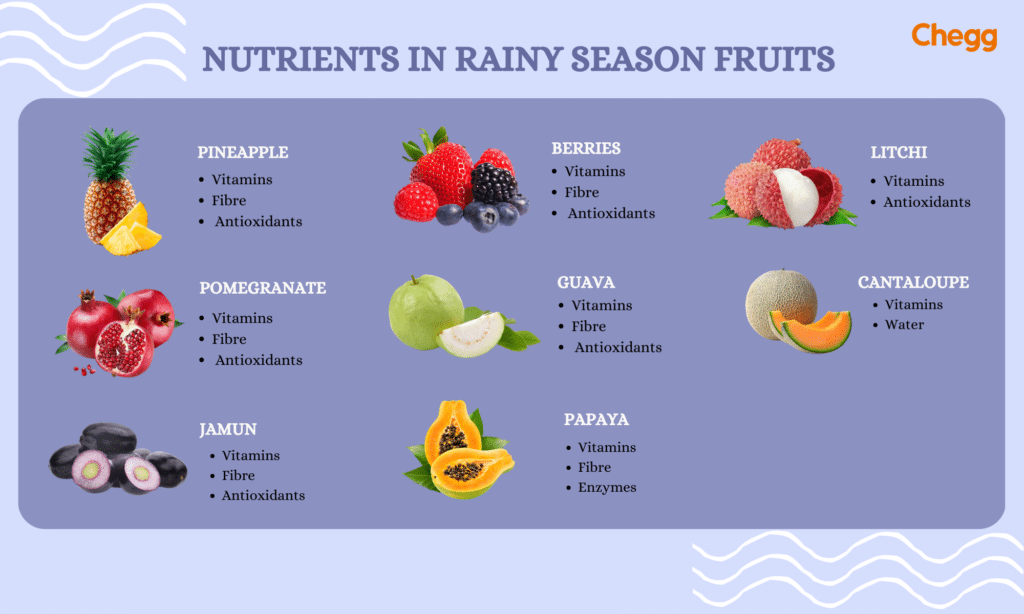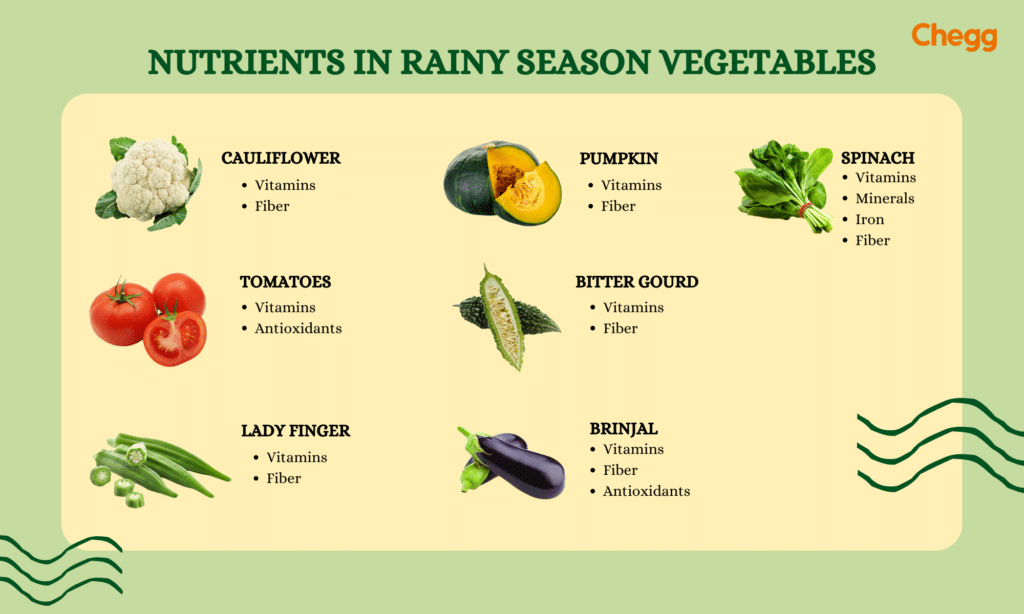
Quick Summary
Table of Contents
In India, the rainy season is more than just a weather change—a vibrant celebration of nature’s revival. As the scorching summer heat fades, the land awakens with lush greenery and shimmering raindrops, transforming the landscape into a refreshing paradise. The monsoon replenishes water sources and breathes new life into agriculture. With it comes an array of rainy season fruits in India, turning this time into a mouthwatering culinary delight for people across the country. Ready to taste nature’s monsoon magic?
Rainy season fruits in India are tasty, healthy, and grow during the monsoon season. When rain showers nourish the soil and supply the necessary moisture for their growth, these Rainy season fruits ripen and become available. They are renowned for their refreshing taste, high water content, and distinctive flavors. It aids in combating humid and wet conditions. Rainy season fruits aren’t only delicious and excessive in nutrients, minerals, and antioxidants. They assist with general health all through this time of 12 months.
Rainy Season Fruits in India are essential for their seasonality and multiple benefits. These rainy season fruits are high in critical vitamins, minerals, and antioxidants. They assist in building immunity and combat infections common during the monsoon season. In humid temperatures, its high water content keeps people hydrated. Furthermore, they bring diversity to the diet and help to maintain a balanced and nutritious consumption. These rainy season fruits also benefit local agriculture by offering a source of income for many farmers.
Eating rainy season fruits is highly beneficial for several reasons. Here’s why you should include seasonal fruits in your diet during this time:
1. Boosts Immunity
2. Detoxifies the Body
3. Provides Essential Nutrients
4. Improves Digestion
5. Hydrates the Body
6. Balances Body Temperature
7. Supports Skin Health
8. Reduces the Risk of Water-Borne Diseases
9. Easily Available and Affordable
10. Helps in Weight Management
11. Improves Mental Health
12. Promotes Overall Wellness
Incorporating these nutrient-rich and hydrating fruits into your diet during the rainy season can keep you healthy and energized and help you make the most of the season.
During India’s monsoon season, many delectable fruits and vegetables thrive, adorning the gastronomic landscape. Rainy season fruits in India, like mangoes, lychees, and Jamuns, provide a sweet and tangy reprieve throughout the rainy season. Simultaneously, vegetables such as spinach, bitter gourd, and okra add a variety of textures and flavors to traditional recipes. These rainy season fruits in India are a treat for the taste buds and a powerhouse of nutrition. They are high in vitamins, minerals, and antioxidants, which help increase immunity and overall health. These rain-kissed delicacies monument to the natural wealth and lively diversity that the Indian subcontinent experiences during the monsoon season.
Also Read:-
These popular wet-season fruits have extensive flavors and several health blessings, including better immunity, digestion, pores, and skin health. They are high in critical vitamins, materials, antioxidants, and nutritional fiber, making them a superb addition to a well-balanced and healthful food plan throughout the monsoon season. This table includes rainy season fruits in India or seasonal fruits in India in August, including their name, description, area and soil needs, health advantages, and nutritional content:

| Fruit | Description | Area and Soil Requirement | Benefits for Health | Nutrition Content | |
| Pineapple | Color: Yellow Taste: Sweet and tangy, tropical | Area: Grows in various regions Soil: Well-draining, loamy soil | It is high in vitamin C and improves digestion. Improves immunity and provides energy. Tropical sweetness gives you energy. Antioxidants promote healthy skin. | Vitamins | |
| Fibre | |||||
| Antioxidants | |||||
| Litchi | Area: Grows in various regions. Soil: Well-draining, loamy soil | Color: Translucent, white. Taste: Sweet and slightly | A high vitamin C content benefits the skin. Increases immunity and fights illnesses. Sweet and transparent, it hydrates. It fights infections and rejuvenates. | Vitamins | |
| Antioxidants | |||||
| Jamun | Color: Dark purple-black Taste: Sweet and tangy | Area: Thrives in subtropical areas. Soil: Deep, well-drained soil | Diabetes is managed, and digestion is aided. Antioxidants improve skin health. The sweet-tangy flavor promotes heart health. | Vitamins | |
| Antioxidants | |||||
| Fiber | |||||
| Guava | Area: Grows in various regions. Soil: Well-drained, loamy soil | Color: Green to pink. Taste: Sweet with a unique | Immune booster due to high vitamin C content. Aids digestion and weight management. The distinct sweet flavor supports healthy skin. | Vitamins | |
| Antioxidants | |||||
| Fiber | |||||
| Berries | Area: Grows in diverse climates. Soil: Well-drained and fertile soil | Color: Various varieties (blue, red, and purple). Taste: Sweet and tart | It is prosperous in antioxidants, supports heart health, and improves skin. It enhances memory, aids digestion, and provides hydration. It supports eye care, helps to manage weight, and increases immunity. | Vitamins | |
| Fiber | |||||
| Antioxidants | |||||
| Papaya | Color: Orange Taste: Sweet and slightly | Area: Grows in diverse climates. Soil: Well-drained and fertile soil | Area: Suitable for a range of climates. Soil: Well-drained, acidic soil | Vitamins | |
| Fiber | |||||
| Enzymes | |||||
| Pomegranate | Color: Ruby-red Taste: Sweet and tangy | Area: Suitable for a range of climates Soil: Well-drained, loamy soil | Antioxidants help to maintain heart health. The sweet-tangy flavor improves memory. It improves skin and provides essential hydration. | Vitamins | |
| Antioxidants | |||||
| Fiber | |||||
| Cantaloupe | Color: Orange Taste: Sweet and refreshing | Area: Grows in various regions Soil: Well-drained, sandy soil | A high water content is beneficial to kidney health. Sweet and refreshing, it promotes weight loss. It cools the body while being low in calories. | Vitamins | |
| Water |
These rainy season vegetables are essential in Indian cuisine and provide a variety of flavors and health advantages. They aren’t the most straightforward, tasty additions to food but contain critical factors that help a nicely balanced and nutritious weight loss program. During the monsoon season, devour those vegetables to live wholesomely and enjoy the flavors in your meal. This table includes rainy season vegetables in India, including their name, description, area and soil needs, health advantages, and nutritional content:

| Vegetable | Description | Area and Soil Requirement | Benefits for Health | Nutrition Content | |
| Spinach | Color: Dark green Taste: Mild and slightly earthy | Area: Thrives in tropical areas. Soil: Well-drained, loamy soil | It is high in iron and vitamins, supports bone health, and boosts immunity. It supports digestion, aids in weight management, and improves skin. | Vitamins | |
| Minerals | |||||
| Iron | |||||
| Fiber | |||||
| Bitter Gourd | Color: Green Taste: Bitter | Area: Suitable for a range of climates. Soil: Well-drained, loamy soil | Manages blood sugar levels. Aids in digestion. Promotes weight loss. It supports liver health and enhances immunity. | Vitamins | |
| Fiber | |||||
| Lady’s Finger | Color: Green Taste: Mild and slightly slimy | Area: Grows in various regions. Soil: Well-drained, loamy soil | It is high in dietary fiber, aids digestion, and promotes heart health. It supports weight management, maintains eye health, and boosts immunity. | Vitamins | |
| Fiber | |||||
| Cauliflower | Color: White Taste: Mild and slightly nutty | Affluent in vitamin C, it aids digestion and supports bone health. It is low in calories, promotes healthy skin, and aids weight management. | Area: Grows in various regions. Soil: Well-drained and fertile soil | Vitamins | |
| Fiber | |||||
| Brinjal (Eggplant) | Color: Purple Taste: Slightly bitter taste | Grows in various regions Soil: Well-drained and fertile soil | It is low in calories and supports heart health. It aids in digestion. It is rich in antioxidants. Promotes weight loss and enhances brain health. | Vitamins | |
| Fiber | |||||
| Antioxidants | |||||
| Tomatoes | Color: Green and Red Taste: Tangy and slightly sweet | Area: Suitable for a range of climates. Soil: Well-drained, fertile soil | Affluent in vitamin C, it supports heart health and improves skin It is low in calories, promotes eye care, and aids digestion.. | Vitamins | |
| Antioxidants | |||||
| Pumpkin | Color: Orange Taste: Mild and slightly sweet | High in beta-carotene, it aids in weight management and supports digestion. It provides hydration, supports skin health, and boosts immunity. | High in beta-carotene, it aids in weight management and supports digestion It provides hydration, supports skin health, and boosts immunity. | Vitamins | |
| Fiber |

Enjoy these vibrant and nutritious rainy season fruits in India to boost your health, energy, and immunity during the monsoon!
Monsoon fruits in Maharashtra give a delicious and juicy experience as the rain-soaked earth breathes life into the orchards and fields, making it a culinary paradise for fruit experts. This table contains information about Maharashtra’s rainy season fruits, including their name, description, area and soil requirements, health advantages, and nutritional content:
| Fruit Name | Description | Area and Soil Requirement | Benefits for Health | Nutritional Content |
| Alphonso Mango | Yellow skin with a sweet, aromatic taste | Thrives in the Konkan region | It boosts immunity and supports eye health. It promotes digestion and enhances skin growth. | Vitamins |
| Minerals | ||||
| Antioxidants | ||||
| Fiber | ||||
| Jamun | Dark purple to black, and the taste is sweet and tangy. | Grows in various regions | It manages diabetes. It aids digestion and improves skin. It is rich in antioxidants and supports heart health. | Vitamins |
| Antioxidants | ||||
| Fiber | ||||
| Guava | Green with a distinct aroma and sweet taste | Suitable for diverse climates | It is high in vitamin C and boosts immunity. It aids in digestion and promotes weight management. It supports skin health. | Vitamins |
| Antioxidants | ||||
| Fiber | ||||
| Pomelo | Large citrus fruit with a mild sweet taste | Thrives in warm climates | Rich in vitamin C aids digestion, supports eye health, promotes weight management, and enhances skin health. | Antioxidants |
| Vitamins | ||||
| Custard Apple | Green, scaly skin, sweet and creamy flesh | Suitable for subtropical regions | It supports digestion, provides energy, aids weight management, enhances skin health, and boosts immunity. | Fiber |
| Vitamins | ||||
| Kokum | Small purple fruit with a tangy taste | Grows in the Konkan region | It aids in digestion and promotes heart health. It supports weight management. It provides relief from acidity and enhances skin health. | Antioxidants |
| Vitamins | ||||
| Karvanda (Carissa) | Small red to black fruit with a tart flavor | Thrives in various regions | High in vitamin C. It aids digestion and supports weight management. It boosts immunity and improves skin health. | Vitamins |
| Antioxidants | ||||
| Fiber | ||||
| Sapota (Chikoo) | Brown skin with sweet, grainy flesh | Suitable for diverse climates | It provides energy. It aids in digestion. It supports bone health. It boosts immunity and enhances skin growth. | Vitamins |
| Minerals | ||||
| Fiber | ||||
| Starfruit | Yellow with a unique star-like shape | Thrives in warm climates | It manages diabetes, aids digestion, and improves skin. It is rich in antioxidants and supports heart health. | Vitamins |
| Fiber | ||||
| Indian Gooseberry (Amla) | Green, sour, and tangy | Suitable for diverse climates | High in vitamin C. It boosts immunity and aids in digestion. It supports heart health and enhances hair and skin growth. | Vitamins |
| Fiber | ||||
| Antioxidants | ||||
| Fig (Anjeer) | Green or purple skin with sweet, seedy flesh | Thrives in warm climates | It supports digestion, provides energy, aids weight management, enhances skin health, and supports heart health. | Fiber |
| Vitamins | ||||
| Jackfruit (Phanas) | Large fruit with sweet, fleshy pods | Suitable for tropical regions | Rich in vitamin C. Aids in digestion promote weight management. | Vitamins |
| Minerals | ||||
| Fiber | ||||
| Indian Jujube (Ber) | Small, round fruit with a sweet and tangy taste | Grows in various regions | Aids in digestion. Supports heart health. Boosts immunity and enhances skin health. Provides energy. | Vitamins |
| Antioxidants | ||||
| Fiber | ||||
| Tamarind (Imli) | Brown pods with a sour, tangy flavor | Suitable for diverse climates | It supports digestion, relieves acidity, enhances heart health, and aids weight management. | Vitamins |
| Minerals | ||||
| Fibers |
The monsoon season brings a delightful change in scenery, but it also requires some adjustments to your diet. Here’s a list of foods to be cautious about during this time:
Street Stall Staples:
Digestive Downers:
Seafood Savvy:
Fresh Produce Precautions:
In India, the rainy season is a cultural and culinary celebration and a climatic occurrence. The arrival of a vast assortment of rainy season fruits that are a treat to the tongue and a source of essential sustenance marks the seasonal shift from sweltering summers to soothing monsoons. These rainy season fruits in India symbolize nature’s richness, from the delicious mangoes, known as the “king of fruits,” to the sweet and tart Jamuns. They offer various fitness blessings, improved immunity, progressed digestion, and crucial nutrients and antioxidants.
These culminations are more than only a supply of nutrition; they hyperlink to our past. The monsoons breathe new life into the dry earth and lift our spirits. We celebrate the combination of nature and culture as we savor these luscious gems, making the rainy season in India a time of restoration for both body and soul. The rainy season fruits in India hold a special place in our hearts, offering a burst of flavor and a deep connection to the rhythms of the land.
Guava Juice, the Super Fruit. Packed with nutrients, every 100g of guava contains 40g of magnesium and nearly four times the Vitamin C found in an orange.
Avoid unpasteurized milk and milk-based desserts during the rainy season to prevent stomach infections.
To stay healthy during the monsoon, use waterproof gear, eat vitamin C-rich foods, and maintain good hygiene. Avoid street food, prevent mosquito breeding, wear waterproof footwear, and keep warm.
Some popular seasonal fruits in the monsoon are plums, cherries, lychees, jamun, and pomegranates. These are well suited for the rainy season due to their plump water content and abundant nutrient profiles, packed with minerals and antioxidants that boost your health while keeping you hydrated through the season.
Popular fruits include mangoes, lychees, guavas, and jamuns, which thrive during the monsoon months. These fruits are refreshing and rich in vitamins and antioxidants, making them perfect for boosting immunity during the rainy season.
During the monsoon, opt for apples, pears, pomegranates, lychees, and bananas, as their low water content helps reduce the risk of waterborne diseases. However, consume mangoes cautiously, which may cause skin issues like pimples.

Authored by, Amay Mathur | Senior Editor




Amay Mathur is a business news reporter at Chegg.com. He previously worked for PCMag, Business Insider, The Messenger, and ZDNET as a reporter and copyeditor. His areas of coverage encompass tech, business, strategy, finance, and even space. He is a Columbia University graduate.
Editor's Recommendations
Chegg India does not ask for money to offer any opportunity with the company. We request you to be vigilant before sharing your personal and financial information with any third party. Beware of fraudulent activities claiming affiliation with our company and promising monetary rewards or benefits. Chegg India shall not be responsible for any losses resulting from such activities.
Chegg India does not ask for money to offer any opportunity with the company. We request you to be vigilant before sharing your personal and financial information with any third party. Beware of fraudulent activities claiming affiliation with our company and promising monetary rewards or benefits. Chegg India shall not be responsible for any losses resulting from such activities.